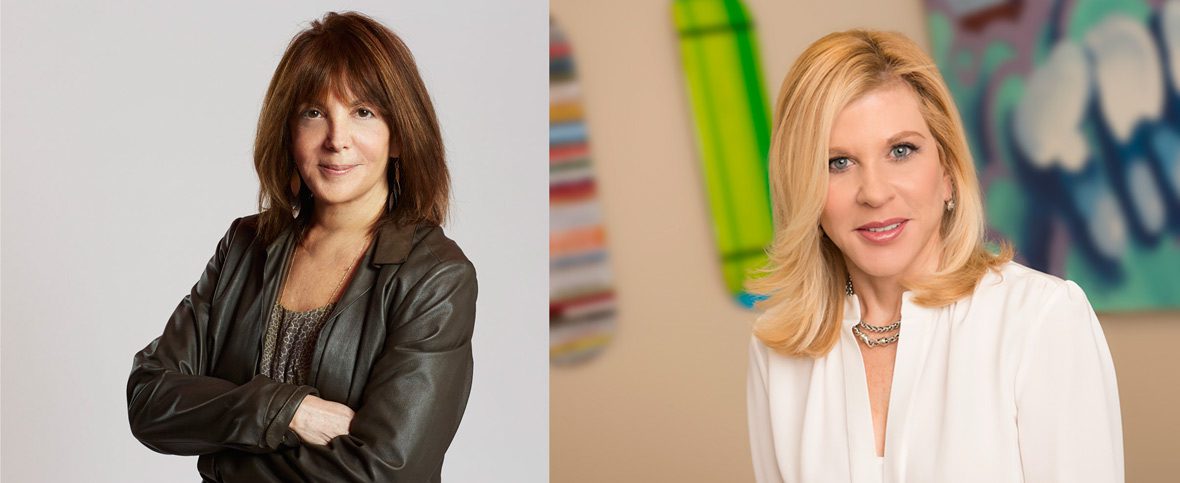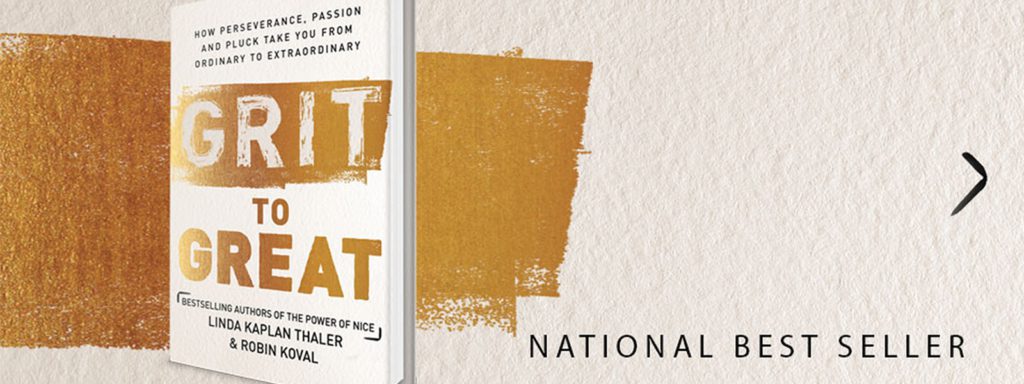By Sarah Dobson
“Talent is cheaper than table salt. What separates the talented individual from the successful one is a lot of hard work.” ~Stephen King
What do Colin Powell, Michael Jordan, and Dave Thomas of Wendy’s fame have in common?
According to Linda Kaplan Thaler and Robin Koval, they share the quality of “grit,” an ability to persevere despite long odds and difficult circumstances. In Grit to Great, Kaplan Thaler and Koval outline their belief that grit has been the real secret to both their own success and that of so many others whom they admire or with whom they have worked.
Through numerous examples drawn from their own lives and the lives of successful people both famous and not-so-famous, Kaplan Thaler and Koval argue both that grit can be learned and taught, and that it’s never too late to get started in developing one’s own grit.
To set the stage, the women share their own story of coming together after travelling similarly winding roads to the advertising business to create the Kaplan Thaler Group, an agency that began in 1997 with one client, six employees and 700-square-feet of office space within Kaplan Thaler’s own home. In 2012, the agency merged with Publicis New York to become Publicis Kaplan Thaler, and the agency now has more than $3 billion in billings and more than 800 employees. Kaplan Thaler was chairman of the new agency before leaving to found Kaplan Thaler Productions where she serves as president.
Koval is now the CEO and president of of IS member, the Truth Initiative, the national public health foundation dedicated to achieving a culture where all youth and young adults reject tobacco.

Linda Kaplan Thaler, president of Kaplan Thaler Productions (left); Robin Koval, CEO and president of Truth Initiative (right). PHOTO: Adam B. Auel
Building on what they learned from their own experience and subsequent research, the co-authors identify what they have found to be the four essential components of grit:
- Guts: the courage to take on a tough challenge, and not falter in the face of adversity.
- Resilience: the ability to see failure as an opportunity versus a fatality.
- Initiative: the ability for self-motivated problem-solving.
- Tenacity: the skill of staying relentlessly focused on a goal.
Perhaps the most important lesson Kaplan Thaler and Koval reiterate for their readers is that grit can be developed and is under our own control, as opposed to innate talent or intelligence, individual circumstances, or the realities of our upbringings. This kind of laser-focus on achieving a goal may actually be less likely to exist in someone for whom early believe that grit is a more reliable predictor of future success than high IQ, social intelligence, or test scores, because one’s “grittiness” can be mindfully developed over time and speaks to one’s experiences and responses to them.
By way of helping readers grow and develop their own grit, the authors close each chapter with “Grit Builders,” practical activities and exercises which can help cultivate this important trait.
But tenacity and focus themselves won’t necessarily always lead to success. Kaplan Thaler and Koval also argue that a realistic, yet optimistic, approach is hugely important. They suggest forgetting about a “dream” and instead setting a realistic goal, taking concrete steps to turn a dream into reality. That realism should be coupled with optimism, however, teaching yourself to view setbacks as temporary conditions that can be overcome, rather than permanent, unchangeable roadblocks. Leaning into new social science research, the women believe that optimism can be learned, by working hard to develop positive emotion, engagement, and meaning.
Along the way, you can’t be afraid of going without a safety net, because if you wait for a no-risk situation, you’ll wait forever and only really risk a lifetime of wondering, “what if?” Even if you do fail, failure can be a great way to learn, teaching you what doesn’t work and making your next attempts that much more successful. Embracing failure further builds your resilience and allows you to bend in a new direction, ultimately gaining a new perspective on your situation.
Grit is not just for the young or for those branching out into a new chapter of their careers or lives, however. Koval and Kaplan Thaler contend that anyone can reach almost any goal with the willingness to work hard and sacrifice, and there isn’t a time or age limit. Don’t accept other people’s age or skill restrictions, but keep moving and challenging your brain in order to keep changing and growing. As they say, referring to the famous fable, “grit—hard work and determination—is like the winning tortoise, while sheer talent and youthful ability is the hare. And we all know who won that race.”
Q: What is the most important lesson for someone looking to take the first step at developing or growing his or her grit? How can one help direct reports develop grit?
The first thing I tell people looking to deepen their grit is to ditch the dream. It’s great to be a positive thinker and believe in your abilities but the belief that “if we can imagine it we can achieve it” won’t make your dreams a reality. There’s an old Jewish proverb that says, “If you want to make your dreams a reality, wake up already.” I think that’s a good guideline for all of us.
Grit has been the subject of an increasing amount of research over the past 10 years. What it shows is that more than intellect, talent, access to financial resources, good looks, popularity, or even emotional intelligence – grit is the one factor most likely to predict future success in school, at work, and in life. And the really great news is that grit is not determined by our genes. We can develop it in ourselves and in others, get more of it, and control it. Essentially, the research says that achieving our goals isn’t about having some elusive “it” factor.
As a first exercise in grit, I encourage people to make a list of the projects that they want to accomplish and then commit to finishing at least one right away. It can be a small, mindless project or one that may require more thought. Then, for one month, commit yourself to finish every project on that list. Knowing you cannot give up will force you to overcome some challenges and to learn new things. This will prove that your abilities are not fixed and can be developed. Remember, our most important talent is having a talent for working hard.
Helping your direct reports develop grit doesn’t cost you a thing, but it pays off big time for all concerned. We can encourage the development of grit in others by providing support and guidance and by allowing those around us to learn on their own. Positive feedback is important. Don’t re-do a direct report’s lousy memo. Instead, tell them (nicely) how they can make it better.
Q: In the book, you discuss how you drew on your own grit to make the decision to apply for your position at Truth Initiative. How have you continued to rely on this trait as you ultimately accepted the job and made your transition to the nonprofit sector?
I think many of us who work in the nonprofit sector feel like David in a sea of Goliaths. I honed my grit while working in the highly competitive, “eat your young” world of advertising, but grit is just as, or even more, important in tackling the challenges faced by nonprofit organizations. As a result, I don’t take my grit for granted. I work on building grit in myself and my organization every single day. As nonprofit leaders, we are in the “business” of working to make the world a better place – often by saving lives. Getting our message heard and making it relevant to those who don’t even realize they need us is a huge challenge. That’s especially true given our attentiondeficit culture and the proliferation of non-stop information. The best part of grit is that no matter how much you have, you can always get more. Grit helps us to continually challenge ourselves and channel our “inner-David” to accomplish great things and make a big difference. In the battle of big versus small, grit is the great equalizer in life.
Q: You spent your final chapter talking about how altruism and cooperation are hardwired into us, and about the personal benefits of volunteering and working for positive social change despite the challenges. How can nonprofit organizations harness these truths across their staff and volunteer base to better focus on achieving their goals? How can they help create useful goals along the way when working on problems that won’t be solved for decades, or may never be entirely solved?
One of my favorite quotes is from General Douglas McArthur who said, “Age wrinkles the skin, quitting wrinkles the soul.” Having grit means you never give up. Therefore, it’s important to get in the habit of celebrating the small victories along the way. Doing so helps fuel your tenacity and determination. The challenge and opportunity for non-profits is to focus on the journey. Set small goals that can be achieved often by staff or volunteers and keep your eyes on the long-term mission. Grit is a marathon, not a sprint.
A growing body of scientific research argues that the act of helping another person triggers activity in regions of the brain involved in pleasure and reward. In other words, helping others – which is inherent in the work of nonprofit organizations – is like satisfying a personal desire.
Appreciating small successes motivates us to go on no matter the circumstances and regardless of whether or how much we get paid. The good news is that research shows the more challenging the problem, the more satisfaction we feel in trying to solve it.
Q: How is the idea of grit uniquely useful in the nonprofit sector?
Today, consumers are telling us that they don’t just want brands to buy, they want brands that stand for ideas they can buy into. This new consumer mindset aligns perfectly with the nonprofit sector, but it also means there is increased competition. Many for-profit companies and brands are now in the business of marketing “for social good” as a way to sell their products and services. As a result, grit is even more essential in helping nonprofits succeed.
This is especially true at Truth Initiative. Our battle to prevent youth from starting to smoke is a living exercise in grit. When we began our work in 2000, the youth smoking rate was 23 percent. Today, it is seven percent. We have countered the nearly $10 billion a year that Big Tobacco spends in the U.S. to promote its addictive products, been sued and won, and evolved to keep our campaign relevant from generation to generation: from the rebellious Gen X, to the optimistic Millennials, and now the responsible Gen Z. With true grit, we have reinvented truth® as a modern movement driven by our award-winning #FinishIt campaign to inspire today’s youth to be the generation that ends smoking.
Q: What is one of your current goals that you might have considered “too difficult” before you embraced the idea of grit?
Taking on the tobacco industry, which is formidable – both politically influential and well-funded – could seem too difficult without a grit-mindset. But I believe that the power of young people to create change is just as formidable if we tap into the incredible social power and influence of today’s youth and encourage these future leaders to develop their own grit. We’ve made great progress, but our work won’t be complete until every community in our nation is protected from the burden of tobacco-related disease and death. I really believe it when we say this is the generation that will #FinishIt.
Q: Any other key takeaway message you would like to share with our readers?
Often, grit is thought of as being rigid and unswerving like an oak tree. In reality, having grit means being flexible, embracing failure, not letting it distract us and bouncing back from setbacks. It’s less about being a mighty oak and more about being able to sway in the breeze, like bamboo.
Bamboo s a very interesting plant. It grows in extreme temperatures, can withstand terrible storms, and survives in the worst soil conditions. Bamboo survives because it adapts.
That reminds me of the story of James Dyson, the vacuum cleaner tycoon. When his attempts to create a new kind of vacuum sucked (or in his case, didn’t), he refused to give up. Ultimately, he tried 5,000 times before he perfected his Dual Cyclone vacuum cleaner. Sir Dyson, who has been knighted by the Queen (who likely has never touched a vacuum in her life), says: “I eventually got to a place I would have never imagined because I learned from what didn’t work.” A hallmark of grit is learning to use what doesn’t work as a springboard for creativity and success.



